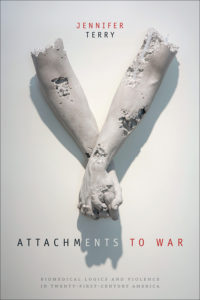Reviewed Book
Attachments to War: Biomedical Logics and Violence in Twenty‐first‐century America. Jennifer Terry, Durham: Duke University Press, 2017, 264 pp.

That modern war and modern medicine are fundamentally related is not on its own a controversial or novel claim, and certainly not for war-making institutions and groups themselves. Indeed, it was only thanks to the ascension of particular health and medical technologies in the late 19th and early 20th centuries—antisepsis, malaria mitigation, surgical anesthesia—that deliberately inflicted enemy deaths outpaced the mortal toll of pathogens and harsh environments to become the privileged register of the costs of war.
Jennifer Terry’s Attachments to War, however, does not merely demonstrate the titular linkage between war and medicine as a strictly practical, technical, or even biopolitical phenomenon. Rather, it shows the centrality of what Terry calls biomedical logics of prevention, cure, rehabilitation, and enhancement in fundamentally shaping contemporary American understandings of organized violence. Deploying an approach that melds science and technology studies with cultural studies, feminist and queer theory, political theory, and anthropology, Terry describes a curious tension in which biomedicine’s promise of salvation—both as literal lifesaving and redemptive rhetoric—actually enables and obscures the death and destruction of war, re-moralizes violence in the guise of care and virtue, and capitalizes on injury as a necessary element in the development of life-saving technological innovation.
The political implications of this “mutual provocation” in which “new forms of wounding and illness generate biomedical knowledge and vice versa” (p. 6) are considerable. The distribution of the costs and benefits of medicine’s complicity with war is steeply unequal across national, racial, and gendered lines—a state of what Terry calls bioinequality, which privileges the sustainment and healing of American military lives while reducing enemies and foreign civilians to “collateral damage” or pathogenic vectors. In this economy of life and death, for instance, a cohort of around 2,000 American military amputees have become the face of an entire conflict, while the hundreds of thousands of Iraqis and Afghans killed by war or condemned to early death by U.S.-inflicted damage to their health systems and infrastructure never make it into the ledger in the first place.
On the U.S. homefront, however, the moral and material economies of war-making and biomedicine, with their parallel promises of protection, freedom, and salvation, are so fundamentally constitutive of hegemonic American desires for a safe and secure society inhabited by whole, healthy, self-improving bodies that there is almost no vocabulary to address such inequalities critically. Terry notes the terrible irony that the open-endedness of post-9/11 “forever wars” has ungrounded the straightforward timelines of sacrifice and redemption that govern collective understandings of the worth of war-related injury and death, creating conditions in which death and destruction can be endlessly capitalized on as a promissory source of healing and hope.
The project of the book is to account for just how thorough this imbrication is and to bring to light the mechanisms of its operation. Readers of MAQ may already be familiar with work that critically elaborates the politics of security state efforts to medicalize war and militarize civilian life (e.g., Theater of Operations, by Joe Masco [Duke 2014]) or that ethnographically explores what it means for soldiers, veterans, survivors, war refugees, and physicians to inhabit tensions like these (like Omar Dewachi’s Ungovernable Life [Stanford 2017] or Zoë Wool’s After War [Duke 2015]). Terry’s main substantive chapters—on regenerative medicine and rehabilitation, high-tech prosthetics, and biosecurity—echo elements of these other works.
This book, however, pays special attention to the rhetorical and institutional terrain on which these technologies arise as encultured and structural attachments to war. Such technologies are often presented as the unmediated results of technoscientific virtuosity—a neurocommunicative limb that lets its user “feel” the surfaces they touch—or of regrettable geopolitical exigency—mass-produced anthrax vaccines to combat anticipated bioterror attacks. Terry shows how such neutral- or benign-seeming objects are actually the products of a complex web of financial, political, and affective investment: security doctrine and political rhetoric that make them necessary and morally imperative, public–private partnerships and lucrative no-bid contracts that make them profitable, and feel-good TED talks and human-interest journalism that promise a redemptive, healed, and enhanced future in the face of war’s human costs. Attachments to war, this book compellingly demonstrates, are not merely a matter of biopolitical instrumentality, but of performed spectacle and virtuous wealth that paper over unrecognized suffering and disposable life.
It is a central tenet of the anthropology of biomedicine that this modality of healing is constituted by a tense dialectic between the moral and caring on the one hand and the technical and dominating on the other. And, in this sense, some readers may object to the way the book sometimes frames logics and practices of care as ideological mystifications serving primarily to prop up techniques of domination. But none of us are immune to the seduction of war’s salvific attachments and redemptive promises, and all will have something to learn here. This book provides a set of tools that will be valuable to students and established scholars alike for prizing apart and connecting together these attachments in new and vitally necessary ways.
References Cited
Dewachi, O. 2017. Ungovernable Life. Stanford, CA: Stanford University Press
Masco, J. 2014. Theater of Operations. Durham: Duke University Press.
Wool. Z. 2015. After War. Durham: Duke University Press.